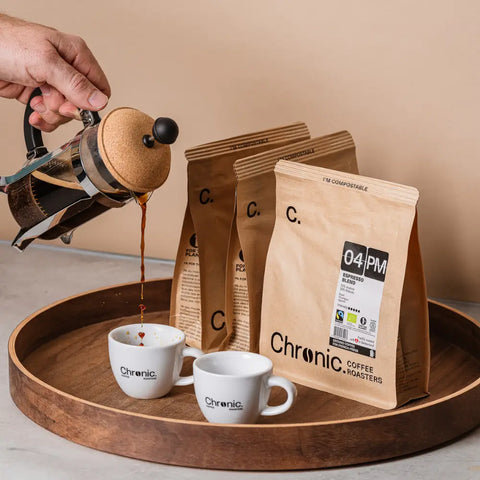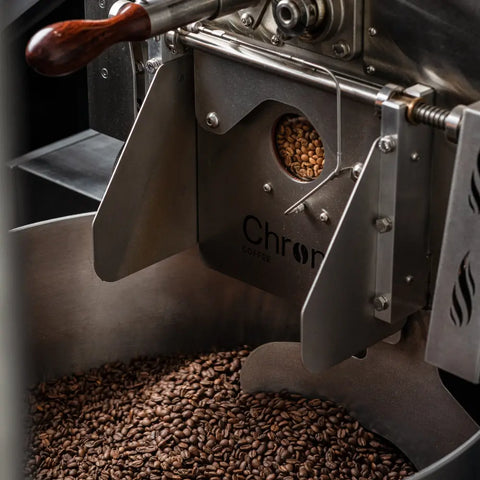How to Use a French Press: The Simple and Complete Guide
Already have a French Press at home or thinking about getting one? Good news: you're about to discover one of the simplest and most satisfying ways to make rich, intense, and aromatic coffee. No need for a complicated machine, precise pressure, or paper filters, just some coarsely ground coffee, hot water, and a well-used French Press.
This isn’t about vague recipes. It’s a real experience: understanding how the French Press works, why it gives such a round, full-bodied taste, and how to get the most out of it, cup after cup. Whether you're new to slow coffee or already a fan, this guide is here to help you brew with ease and enjoyment.
We’ll cover the ideal water temperature, the right grind, proper ratios, and the small gestures that make a big difference. By the end, you’ll know how to use your French Press like a home barista. Promise — it’s easier than you think, and a thousand times better than anything from a capsule machine.
Table of Contents
- Why Choose a French Press?
- The Essentials You Need to Use a French Press
- Step-by-Step: How to Brew Coffee with a French Press
- How to Personalize Your French Press Coffee
- Common French Press Mistakes to Avoid
- Conclusion: A Simple Method for Seriously Good Coffee
Why Choose a French Press?
The French Press might look simple, but when it comes to taste, it packs a punch. Tired of bland coffee or lifeless capsules? This method is made for you. Here’s why.
1. A straightforward, no-fuss method
No complicated machines, no pods, no paper filters. Just heat your water, add your coarsely ground coffee, pour, wait a few minutes, press… and that’s it. You don’t even need to be fully awake to make it happen.
2. A rich, intense coffee full of aroma
The long and gentle brew draws out the full body of the coffee — including the aromatic oils that paper filters trap. The result? A round, textured cup with real depth. Perfect for exploring the nuances of a well-roasted coffee bean.
3. Almost zero waste
No pods, no plastic, no disposable filters. Just coffee grounds you can compost or use as fertilizer. A French Press is a more sustainable way to enjoy your favorite brew.
4. Easily adaptable to your taste
Prefer something lighter? Adjust the dose or steeping time. Want it bolder? Steep a bit longer. The French Press adapts to your preferences — not the other way around.
5. Perfect anywhere, anytime
At home, at the office, on vacation, even in a van — all you need is hot water and a few minutes. With a kettle or even a saucepan, you can enjoy real coffee wherever you are.
The Essentials You Need to Use a French Press
Brewing good coffee with a French Press starts with the right gear. Nothing fancy — just a few well-chosen tools that make all the difference in your daily ritual. Here’s what you’ll need for a smooth and satisfying brew.
1. A French Press, plain and simple
This is your foundation. You don’t need a high-end model, but go for one built to last: a heat-resistant glass carafe, a well-fitting lid, and a solid plunger with a metal filter system (essential for full flavor).
There are versions made from stainless steel or ceramic, but glass lets you see the water level and the brewing process — especially handy if you’re just getting started.
Pro tip: most models are labeled by number of “cups” — but one “cup” is about 100 ml. For two full mugs, a 4-cup French Press is usually just right.
2. Coffee beans… or pre-ground for French Press
This is the game changer. If you want rich, balanced flavor, skip the industrial pre-ground coffee. Ideally, buy whole beans and grind them coarsely just before brewing — that’s how you get a full, aromatic cup without unwanted bitterness.
No grinder? No problem. You can also buy your coffee already ground, as long as it’s made for French Press (coarse, like sea salt). It’s a great option if you want something quick and easy.
Tip: whether you use whole beans or pre-ground, choose freshly roasted coffee. Our 10AM (smooth and nutty) and 01PM (fruity and expressive) are available in both formats, perfectly suited for French Press brewing.
3. A kettle (or any way to heat water)
You don’t need a temperature-controlled machine, but you should be able to heat clean water to the right temperature — between 90 and 94 °C (not boiling).
No thermometer? Just let your water rest for 30 seconds after boiling — that’ll bring it to the perfect brew temp.
4. A wooden or plastic spoon (no metal in the glass)
You’ll need it to gently stir your coffee after adding the water. A regular tablespoon works fine. Wood or plastic avoids scratching or cracking the glass carafe.
5. A scale (or a solid scoop)
Not essential, but if you want to dial in your water-to-coffee ratio precisely, a small kitchen scale will help you get it just right. Standard ratio? 60 g of coffee per 1 liter of water.
For a regular 250 ml cup, aim for about 15 g of ground coffee.
6. A coffee grinder (manual or electric)
Without a grinder, you can’t control your grind size — and the French Press needs a specific coarse grind to work well.
A grinder with adjustable settings lets you fine-tune the grind to match your taste, your beans, and your preferred intensity.
Step-by-Step: How to Brew Coffee with a French Press
Now that you’ve got everything you need, let’s dive into using your French Press. Here are the steps to make a bold, character-rich cup without surprises. Follow them in order, and you’ll get consistent results every time.
1. Preheat your French Press
Start by rinsing your glass carafe with hot water. This preheats the vessel, avoids temperature shocks, and helps maintain the ideal brewing temp.
While that’s happening, weigh your coffee dose. For a balanced brew, use about 60 g of coffee per liter of water — or 7 to 10 g per cup, depending on how strong you like it.
2. Add coffee and pour water
Add your ground coffee to the bottom of the French Press. Use a spoon or pour carefully to keep things clean.
Then heat your water. For French Press, it should be just below boiling — around 90 to 94 °C. If your water just boiled, let it rest for 30 to 45 seconds before pouring.
Pour in the water in two stages:
- First, just enough to soak the coffee and create a bloom (that swelling effect when coffee meets water).
- Wait 30 seconds — this is when aromas start to release.
- Then pour the rest of the water up to your desired level.
3. Stir gently
Use a wooden or plastic spoon to give it a quick stir. This helps with even extraction and keeps the grounds from floating on top.
Avoid using metal in the glass carafe — safer for your gear in the long run.
4. Let it steep without touching
Place the lid on top, but don’t press the plunger yet. Let the steam escape through the filter system and allow the coffee to brew undisturbed.
The ideal brew time is 3 to 4 minutes, depending on how strong you want it and the type of coffee you’re using. Now’s the perfect time to chill or get your favorite mug ready.
5. Press the plunger slowly
Once the time is up, press the plunger gently and steadily down to the bottom. No need to force it — if it resists, your grind is too fine. If it goes down too fast, it’s too coarse.
This step separates the grounds from your drink and gives you a clean, full-flavored cup.
6. Serve right away (don’t let it sit)
Pour your coffee into cups or a carafe immediately. If it sits in the French Press, it keeps brewing — and will turn bitter.
Now you’re ready to enjoy your coffee, still hot, with all the rich aroma this gentle method brings out. Want to go further? Check the next section for tips.
How to Personalize Your French Press Coffee
One of the French Press’s biggest strengths is its flexibility. You can tweak the recipe based on the taste you’re after, how much water you’re using, or the type of coffee you love (we recommend a good Arabica, for starters).
Here are a few quick tips to customize your brew:
- Want a lighter cup? Use less coffee (6–7 g per cup) or shorten the brew time slightly.
- Craving something stronger? Steep for longer (up to 5 minutes) or up the dose to 10 g per cup.
- Into fruity or floral notes? Try Ethiopian or Kenyan beans. More chocolatey? Go Central America.
- Making coffee for a group? No problem — French Presses come in all sizes, and the method stays the same.
Usage tip: Non-boiling water, a proper coarse grind, and a snug-fitting lid are often all it takes to turn your coffee moment into something special.
Common French Press Mistakes to Avoid
Even though using a French Press is simple, there are a few common mistakes that can mess with your brew. Here’s what to watch out for:
- Grind too fine
It slips through the filter and makes the coffee muddy or bitter. Go for a coarse grind — it’s essential. - Pouring boiling water
Too hot and you burn the flavor. Let it cool slightly before pouring (30–45 seconds). - Wrong brew time
Too short = weak coffee. Too long = bitter. Aim for that 3–4 minute sweet spot. - Letting it sit after pressing
The grounds keep brewing. To avoid over-extraction, pour everything out right away. - Neglecting the filter system
A dirty filter messes with the taste. Keep it clean for consistent quality. - Lid or plunger not properly aligned
This can cause leaks or mess with the plunge. Always double-check the setup.
Conclusion: A Simple Method for Seriously Good Coffee
In the world of coffee, the French Press is one of the easiest and most effective ways to brew coffee that truly reflects your taste. No espresso machine or high-pressure tech — just a French Press, a few good habits, and a bit of patience.
It’s a more direct, sensory way to make coffee — no waste, no fuss, just full-on flavor. And unlike stovetop or automatic machines, you control every variable: water volume, steeping time, grind size — and ultimately, the flavor in your cup.
Using a French Press is a ritual in itself: simple, mindful, and deeply satisfying. And if you want to get started in the best conditions, we’ve got you covered with a ready-to-brew pack featuring a quality French Press and three pre-ground coffees, specially crafted for French Press brewing. Perfect for starting out — or for gifting to a curious friend.






